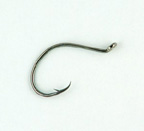Set
The hook must penetrate the oral cavity of the fish before it can be reeled in. The hook is set by tightening up on the fish--this means reeling in the slack line and smoothly but sharply sweeping the rod either upwards or sideways. Enough force must be generated to have the hook point penetrate into fish tissue.
Many factors influence the hook set. First, the hook’s point must be inside the fish’s jaws. If the fish is nibbling at a piece of the bait outside the hook, setting the hook will pull the hook away from the fish. This means you must wait until the hook is inside the fish’s mouth. With larger fish, this isn’t a problem, but the smaller fish seem to nibble around the bait’s loose ends. So wait until the line moves or until the fish swims off with the bait. Then tighten up and sweep the rod to cause enough pressure for the point to penetrate.
When bait fishing with circle hooks, you don’t need to even set the hook. You simply wait for the fish to swim off and gradually increase tension by slowly reeling and then speeding up the retrieve. The hook will be pulled into the corner of the fish’s jaw. This is the ideal hooking place because

the jaw bone tissue is strong and the hook is set into a secure place where you have the best chance of landing the fish. Also the hook does little or no damage there and the fish can be safely released. So circle hooks are the best ones to use when bait fishing.
When using artificial lures, the lure will be rejected as soon as the fish discovers that it is a fake. Most fish suck in the lure and they can expel it nearly as easily. The vacuum action of the gills flaring draws in the lure and the water around it. When I’m fishing artificial bait, I set the hook immediately and firmly by sweeping the rod in an upward or sideward motion. The sweep is a smoothly accelerated motion and at its end I pull with increased tension.

© 2026 The Gale Group, Inc. All rights reserved.
© 2026 Perigee Learning LLC. All rights reserved.
LoveTheOutdoors.com is owned and operated by Advameg, Inc. © 2026 Advameg, Inc.
Camping Adventures • Dutch Oven Cooking • Sports Knots
Fly Tying • Freshwater Fishing • Fly Fishing

